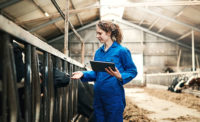Easier to be 'green'

Hormel’s brand new Progressive Processing plant in Dubuque, Iowa, opened earlier this year and recently became one of the first new-construction manufacturing facilities to earn gold-level LEED certification. Given that Hormel has put itself squarely in the spotlight among processors maintaining and advancing a sustainable strategy, Chad Sayles, manager of mechanical and electrical engineering, sat down with Andy Hanacek, editor-in-chief of The National Provisioner, to discuss ways in which meat- and poultry-processors can continue to design more environmentally friendly, “green” facilities.
- Editor’s Note: What follows is the complete conversation between Hanacek and Sayles—a ProvisionerOnline.com exclusive—including those questions and answers found in The National Provisioner publication, along with a bevy of questions not published in print due to editorial space constraints. We bring these answers to you in this format, knowing that information on sustainability and green facility design is valuable, particularly from the perspective of a processor.
Hanacek: From the overall point of view, what was the single biggest challenge for Hormel in designing a prepared foods/meat processing facility to meet the qualifications of a LEED-certified facility?
Sayles: No. 1, by far, the LEED-certification process was never developed for a manufacturing facility, and certainly not a refrigerated food-manufacturing facility. The criteria were developed with commercial offices, libraries, schools, etc. in mind. So a lot of the things you have in a manufacturing plant don’t apply to the criteria, and the challenge was for us to figure out how to make our systems comply with or exceed that criteria, even though they were specialized.
The energy model we had to develop to demonstrate that our facility was more energy-efficient than a base building, it’s really hard to develop a base building that matches Progressive Processing. There aren’t hundreds of these buildings making products in microwave trays to which you could compare your energy consumption.
Hanacek: What are some of the cost differences involved in going from a green-field site to a green facility, rather than building a “typical” plant? Is it a big difference or just more an awareness and study-driven process?
Sayles: We believe in our case there was really a minimal cost difference, because we at Hormel have a long history and tradition of energy conservation and the things that are now collected under the label of “green building.” We’ve done most of those things anyway, so going into a new facility, we would have implemented most of this technology anyway, because we believe it’s good business to do so — that energy-saving designs will save us energy for the life of that building.
Hormel tends to be in its buildings for a very long time. At the [grand opening] press conference, I made the comment to the effect of, we could have had the same press conference 28 years ago at the opening of the new Austin [Minn.] plant and had the same discussion, it’s just that none of this was in the vocabulary at the time.
Hanacek: And the ROI is pretty good in terms of the costs there too, right?
Sayles: Right, and I made this point at the grand opening too: that it’s much better to build a new facility, where you have nothing, and you choose Option A or Option B, and Option B saves you a substantial amount of energy, rather than going into an old facility that has a working system and have to replace that. The economics aren’t as favorable to do that, so the right thing to do is to do it the best you can the first time.
Hanacek: Obviously, construction materials aside, can processors use any of these green tools to, say, retrofit current facilities? What are some of the ways in which a processor could incorporate some of these sustainable practices into their facilities?
Sayles: From the energy-management standpoint, there are things like high-efficiency lighting that you can do in a facility of any age. You can evaluate the amount of kilowatt-hours your lighting system takes, look at the best available technology and build a business case to replace anything that’s probably more than five years old because of the way the technology has changed. Lighting, waste, heat recovery, manufacturing in general has a lot of processes that use heat to cook or process, and a lot of that heat is wasted out an exhaust stack—you can try to recover that and use it in the plant.
Then, water conservation is huge. Anyplace that you have water that makes its way to the drains, is there any way to collect and use it again? Is there a way to close the loop, or maybe not even need the water in the first place? There are a lot of ways in our industry to retrofit existing facilities, again it’s simply more challenging and often more costly.
Hanacek: Are there now enough resources in terms of companies, equipment and technology that a processor doesn’t have to design or develop these strategies and processes on their own?
Sayles: Yes and no. The lighting, the use of natural light via skylights, those are technologies for which there are a lot of great manufacturers and consultants who would be very qualified to help a processor. When it comes to looking at your particular process in something like, say, waste heat recovery, there are people who sell heat exchange equipment that wasn’t available a few years ago, but having the equipment is only half the battle. The rest of it is understanding your process enough and knowing what your process can do and where you can use that recovered waste heat. You can’t depend on someone just to walk in off the street and tell you to use this heat exchanger to grab all your heat off the blancher or inedible rendering cooker or whatever. There are people who sell the equipment, but you must understand how to apply it to your process. We’re a similar industry, but plant to plant and company to company, there are significant processing differences.
Hanacek: Where do you think there is further room for the technology of sustainability to improve in the meat industry?
Sayles: I think it’s going to improve in water conservation and energy reduction but also recovery. Again, it’s manufacturing in general, not just food manufacturing, as opposed to the commercial building industry. In food manufacturing, you have to consume energy to manufacture product, and there are a lot of opportunities to capture and reuse some of that.
I think the things that will happen with technology, the lighting and controls area is just phenomenal—think of how computers continue to grow. The things we are able to do at Progressive Processing in the control of systems allow us to do what we do sustainably. If this was 25, 30, 40 years ago and we didn’t have that computer in the background monitoring outside and inside light levels and deciding how to stage the lights, what we’d have would not be effective. You’d have to have a guy standing at the switch turning it on and off as the sun moved up and down, and I think the biggest opportunity for advancement, is through the controls aspect.
Hanacek: With regard to green facility design, how can a meat-processing facility minimize its emissions and impact on the local environment? How far has emissions control technology come thus far in this particular area?
Sayles: New equipment in our facilities such as boilers and processing ovens are designed with the latest combustion control technologies resulting in lower emissions. Older equipment is retrofitted as needed. The technology used for this combustion control is the same as used in other industries and continues to improve. But, the most effective way to reduce emissions is to reduce the energy consumed in the plant. Efforts to design processes to be energy-efficient, utilize the most energy-efficient equipment available and recover energy for a secondary use have significantly reduced the energy consumed and therefore reduced emissions.
Looking for a reprint of this article?
From high-res PDFs to custom plaques, order your copy today!





